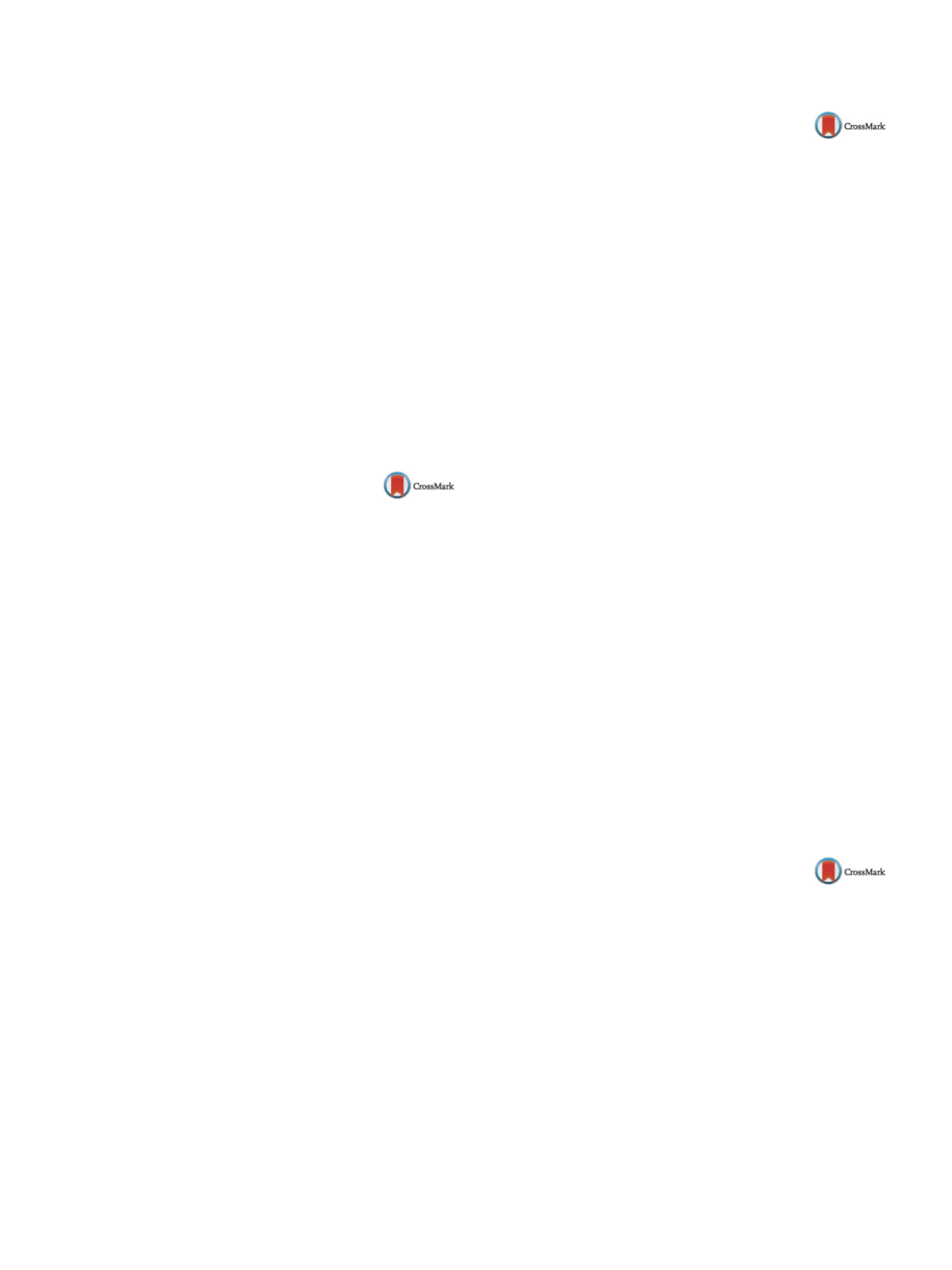

S74
25th European Congress of Psychiatry / European Psychiatry 41S (2017) S69–S105
2012. Forty-five consecutive indoor patients diagnosed with bipo-
larmood disorder usingDSM-IV-TR criteriawere selected. On day 1,
blood was collected for thyroid profile and BPRS 24 item scale ver-
sion 4.0 was applied. They were started on lithium monotherapy
and only lorazepam was used on S.O.S basis. On day 30, the BPRS
was applied again to check the response to treatment, statistical
analysis was done using SPSS version 16.
Results
The mean percentage fall of the BPRS score was 40%, with
the maximum fall in the subscale of grandiosity and minimum for
depression. Age, illness duration, substance use, family history sec-
ond or later episodes were negatively correlated with treatment
response. Pretreatment T4 level was positively correlated, while
pretreatment TSH level was negatively correlated with the treat-
ment response.
Conclusion
Lithium monotherapy proved to be a good agent
for first episode of bipolar Mood disorder patients with manic
symptoms and pretreatment T4 and TSH level were predictors of
treatment response.
Disclosure of interest
The authors have not supplied their decla-
ration of competing interest.
http://dx.doi.org/10.1016/j.eurpsy.2017.01.236O015
Use of the polarity index for the
analysis of long-term efficacy of drugs
used in bipolar disorder
L. Borraccino
1 ,∗
, O. Todarello
2, A. Rampino
2, G. Di Sciascio
2,
A. Bellomo
11
Università di Foggia, dipartimento di medicina clinica e
sperimentale, Foggia, Italy
2
Università di Bari, dipartimento di scienze neurologiche e
psichiatriche, Bari, Italy
∗
Corresponding author.
Introduction
The study gathered information in order to draw
useful conclusions to describe bipolar patients and their clinical
management. The data collectionwas conducted as part of RENDiBi
epidemiological study.
Objectives
The statistical analysis of the collected data will be
essential to understand the possible changes in drug treatment,
through the help offered by a parameter, Polarity Index (PI), the
numerical expression of the efficacy profile of a drug, very useful
especially in the long-term management.
Methods
Administration of a first detection card (demographic
data, medical history) and five scales (CGI-BP, Mood Insight Scale,
YMRS, HDRS) and a structured interview (MINI). The parameters
analyzed were: polarity prevalence, ratios efficiency (IE) (values
indicating the effectiveness of treatment compared to manic com-
ponents and/or depressive), treatment and PI.
Results
The degree of correlation between PI and IETot is pos-
itive and statistically significant. The correlation between PI and
IEm is statistically significant; the correlation is however not sig-
nificant between PI and IEd; treatment with antipsychotics alone
has increased PI, while the one with mood stabilizers has lesser;
treatmentwith antipsychotics has increased PI in patientswith pre-
dominantly polarity than those with manic depressive prevailing
polarity.
Conclusions
There is a correlation between PI and effectiveness
onmanic symptoms and it is statistically significant (as already evi-
dent in the literature). The PI is numerically higher in the treatment
of the subject with manic polarity, in agreement with previous
studies that associate to the more effective drugs used for the man-
agement of manic recurrences a higher PI.
Disclosure of interest
The authors have not supplied their decla-
ration of competing interest.
http://dx.doi.org/10.1016/j.eurpsy.2017.01.237O016
Obesity and obstetric complications
are associated with rapid-cycling in
Italian patients with bipolar disorder
A. Caldiroli
1 ,∗
, M. Buoli
1, B. Dell’Osso
1, G.S. Carnevali
1,
M. Serati
1, T. Suppes
2, T.A. Ketter
2, A.C. Altamura
11
IRCCS Foundation Ca’ Granda Ospedale Maggiore Policlinico,
Psychiatry, Milan, Italy
2
Stanford University- School of Medicine, Psychiatry and Behavioral
Sciences, Stanford, CA, USA
∗
Corresponding author.
Introduction
Rapid cycling (RC) worsens the course of bipolar
disorder (BD) being associated with poor response to pharma-
cotherapy. Previous results about clinical variables potentially
associated with RCBD were discordant or unreplicated.
Objectives
An early diagnosis should be the goal to properly treat
RCBD patients.
Aims
To compare clinical variables between RC and non-RC bipo-
lar patients and to identify related risk factors.
Methods
A sample of 238 bipolar patients was enrolled from
three different communitymental health centers. Descriptive anal-
yses were performed on total sample and patients were compared
in terms of sociodemographic and clinical variables according to
the presence of RC by multivariate analyses of variance (MANOVAs,
continuous variables) or
2
tests (qualitative variables). Binary
logistic regression was performed to calculate odds ratios.
Results
Overall, 28 patients (11.8%) had RC. The two groups were
not different in terms of age, age at onset, gender distribution,
type of family history, type of substance use disorder, history of
antidepressant therapy, main antidepressant, psychotic symptoms,
comorbid anxiety disorders, suicide attempts, thyroid diseases, dia-
betes, type of BD, duration of untreated illness, illness duration,
duration of antidepressant treatment and GAF scores. In contrast,
RC patients had more often a history of obstetric complications
(
P
< 0.05), obesity (
P
< 0.05) and a trend to hypercholesterolemia
(
P
= 0.08). In addition, RC bipolar patients presented more fre-
quently lifetime MDMA misuse (
P
< 0.05) than patients without
RC.
Conclusions
Obesity and obstetric complications are risk factors
for the development of RC in BD. Lifetime MDMA misuse may be
more frequent in RC bipolar patients.
Disclosure of interest
The authors have not supplied their decla-
ration of competing interest.
http://dx.doi.org/10.1016/j.eurpsy.2017.01.238O017
Epidemiology of bipolar spectrum
disorder: Results from the general
population survey of South Korea
S. Chang
1 ,∗
, C. Tae Young
2, J. Sung-Won
31
Kyungpook National University Hospital, Psychiatry, Daegu,
Republic of Korea
2
Catholic University of Daegu School of Medicine, Psychiatry, Daegu,
Republic of Korea
3
Keimyung University-DongSan Medical Center, Department of
Psychiatry, Daegu, Republic of Korea
∗
Corresponding author.
Introduction
Patients with subthreshold bipolar disorder (sub-
BP) experience severe clinical courses and functional impairments,
which are comparable to those with bipolar I and II disorders (BP-I
and -II). Nevertheless, lifetime prevalence, socioeconomic corre-
lates and diagnostic overlaps of bipolar spectrum disorder (BPS)
have not yet been estimated in the general population of South
Korean adults.
Aims
This study aimed to estimate the lifetime prevalence, cor-
relates and diagnostic comorbidities of BPS using a validated


















